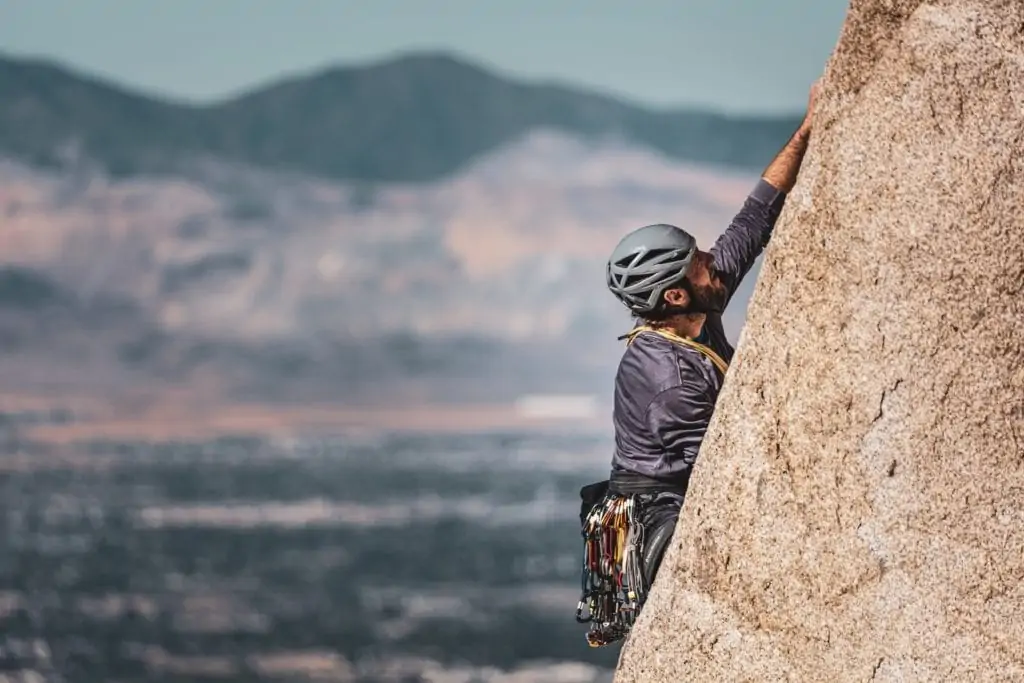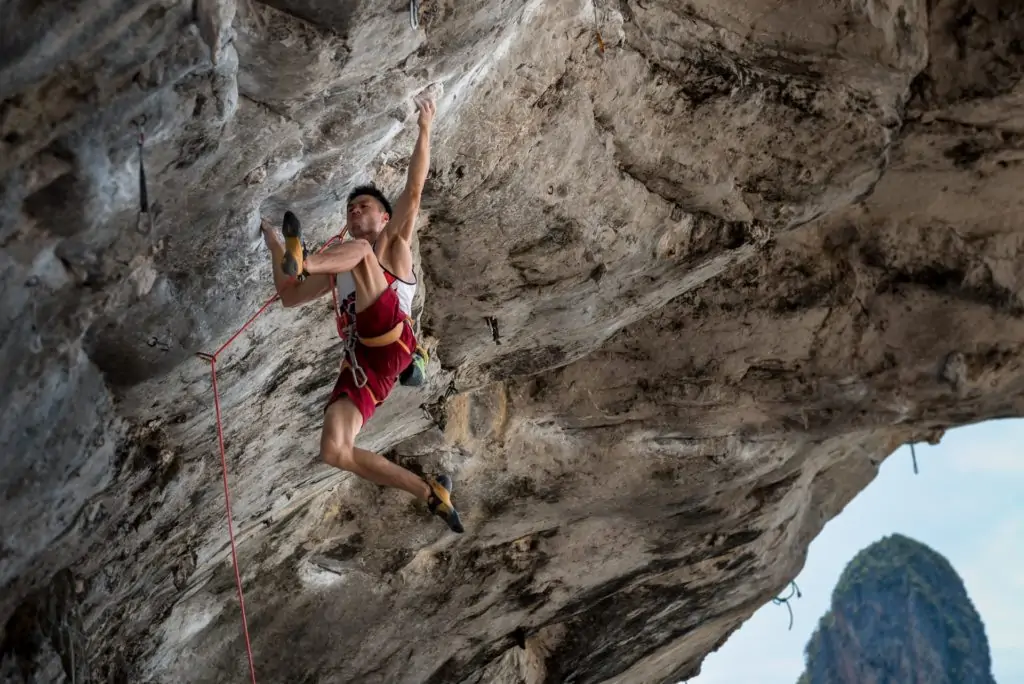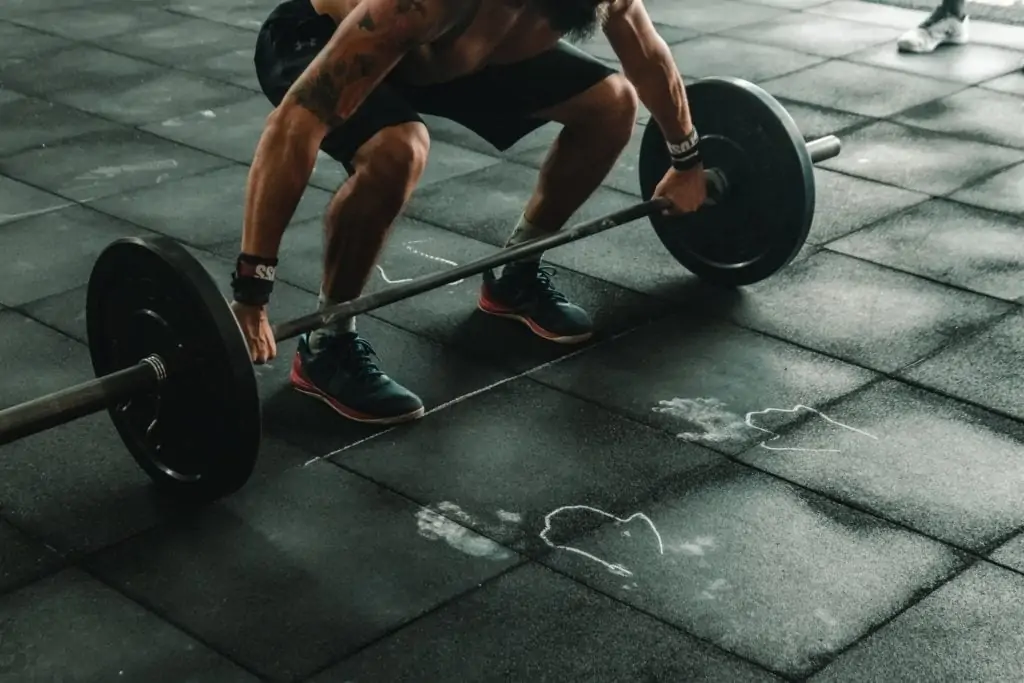You probably heard that rock climbing is known not only for being one of the most fun ways to exercise and socialize but also for being a full-body workout.
However, if you have seen the lean (sometimes even skinny) physique of many experienced climbers, you may be wondering if rock climbing builds muscle and how much.
Good news! Rock climbing definitely builds muscle, but you need to be clear on why and where you want to build muscle.
The muscle mass you build from rock climbing may not be as noticeable as from weight lifting or bodybuilding, but you are not just making your muscles bigger. You are making them stronger, more functional, and you increase their endurance. As we will see, bulky muscles won’t prove very useful in climbing. So it’s always good to first assess your fitness goals and priorities.
After you’re done with this post, you may enjoy our extensive post on 50 rock climbing tips for beginners and intermediates.
 Does Rock Climbing Help Build Muscle Mass?
Does Rock Climbing Help Build Muscle Mass?
When you first start rock climbing, as with any sport, you will soon see some differences in your body, especially if you are committed and climb two to three times a week. You will notice your upper body muscles become more defined, and your whole body will be leaner and toned.
If you climb regularly and consistently, after a few months, you may feel you’re not getting much stronger, and your muscles are not getting any bigger. That’s the point that you really need to develop your technique more, since strength is not the ultimate factor to how good a climber you can be. The strength and leanness of your body will be maintained, and you will be able to climb even harder, even though in appearance, you may not look more ripped.
Your muscles grow to the point that they become efficient in coping with your body weight in functional movements. So you are working more than just an isolated group of muscles and get stronger, but not necessarily bigger.
For people training in a traditional gym, gaining size and muscle mass is often a priority. But having more muscle won’t necessarily make you a better climber. Excessive bulk will hinder rather than help you climb challenging routes because it just means more weight for you to carry upwards.
The best climbers in the world are muscular but very lean. Having said that, if you are not climbing professionally, restricting your muscle mass doesn’t need to be a top priority. You can keep a balance between muscle growth and your climbing performance.
Climbers that only do bouldering tend to be a bit bigger because it uses fast-twitch muscle fibers to complete short, intense problems. On the other hand, people who only do sport climbing, which requires more endurance, usually look leaner. It’s good to do a combination, but again, it depends on what your goals are.
Spending more time on overhang routes that require powerful moves and require you to manage your body weight will also help you gain more muscle mass.
Climbing can make you bigger and stronger, but it mostly improves your overall fitness, endurance, and agility rather than increase your muscles’ size. If your main goal is gaining muscle mass, you should consider combining climbing with weight training.
Can Climbing Help Build Strength?
Rock climbing definitely makes you stronger, especially the first few months. But climbing is essentially bodyweight training; it’s not for bulking. So your muscles need to be strong enough to lift your body weight, but more than that, they will just make you heavier, affecting your performance. Therefore in climbing, after a certain point, proper technique is much more important than strength.
Rock climbing is more about the weight to strength ratio and not so much about strength alone. After a certain point, having more muscle does not compensate in your performance for weighing more. Too much muscle bulk can also make you tighter, especially in your shoulders, which can have an impact on your range of movement and flexibility.
For optimal strength training, you may want to spend more time bouldering, as this study shows that you get higher maximal and explosive strength than lead climbing.
Studies have also shown that the strongest correlation with performance in climbing is finger and forearm strength and endurance. That’s why the most noticeable increase will be in your grip strength. Climbing also strengthens the tendons, which is important, especially in being able to stack your joints to take rests on the wall.
Some argue that the strength you gain with climbing is more relevant and practical than the kind of strength you build weight lifting, for example. So someone who looks more muscular doesn’t mean they are a stronger climber than someone whose muscles don’t look as big and strong. It’s a different kind of strength training.
Many climbers do additional training and exercises for strengthening. If you don’t want to go to the gym or get involved in other types of training, some things you can incorporate into your climbing session to get stronger are:
- Campus for forearm and grip strength, push-ups
- Roof routes, overhangs
- Lots of bouldering (check out our advanced bouldering tips here)
If you are weight lifting or doing other forms of strength training, adding climbing to your schedule will make you stronger and more well rounded physically and mentally.
Read the next section for more specifics on the muscles used in rock climbing!
What Muscles are Commonly Used in Rock Climbing?
Rock climbing is known as a full-body workout for a reason. It requires a large number of muscles from different muscle groups, as well as tendons.
Below you can see which muscles rock climbing works out.
It mainly involves the core, which includes the muscles in the abdominal area and on the back.
Core strength is essential in climbing. All the abdominal muscles (abs) work to stabilize you by helping to hold your body in a specific position and control your center of gravity as you transfer your weight. They remain in isometric contraction, keeping the pelvis in line with your chest. In overhang routes, a strong core keeps you closer to the wall so that your arms don’t have to pull all your weight.
The latissimus dorsi (lats), a large wing-shaped muscle on both sides of your back, also plays a significant role in climbing. It’s responsible for extending the shoulder and required when you pull yourself upward using your arms. The other upper back muscles that work hard when climbing are your rhomboids and trapezius.
The anterior deltoids are also very important in climbing and have to be strong enough to provide your shoulder joint with stability.
As long as the arms are concerned, the biceps brachii (or just biceps) help in pulling your body upward by bending your arms. They are not as powerful as the lats but are essential in overhangs. In certain movements, the triceps also come into play, but not very often.
Often in climbing, you need to hold a lot of your weight with just your fingers in an open grip. The muscles that help you do that are your forearm flexors (flexor carpi ulnaris, flexor carpi radialis, flexor pollicis longus, flexor digitorum superficialis, and flexor digitorum). These muscles are not often put to work in any other conventional type of exercise.
When we start climbing, we tend to use mostly our arms to pull our weight up. When we get used to applying more technique, we learn how to rely on our feet and legs more, to push our body up, rather than just pulling with the arms. The quadriceps work to straighten the legs and propel us upward. We even use our hamstrings when we heel-hook, for example, but that happens at a low rate compared to the opposite movements caused by the quadriceps.
Your glutes and inner thighs also play a significant role in pushing you upwards and stabilizing you.
Balancing our entire body weight on the tips of our toes on tiny holds is possible because of our calf muscles: the gastrocnemius and the soleus.
So as you may have realized by now, every time you climb, your body uses all the major muscle groups, and that’s why it’s known for being a full-body workout that makes you stronger overall.
What Defines a Rock Climber Body?
If you have been at a climbing gym, the crag, or just watched climbing videos, you will have noticed several rock climber body types. Some elite climbers are usually quite lean, if not skinny, with low percentage body fat and body mass, and other elites look like they are in shape, but not too muscular or ripped. And then some climbers look stronger and more muscular, with broad shoulders and super defined abs, but still lean.
The common denominator is that rock climbers have less body fat and more muscle than the general population. Professional climbers don’t really concern themselves with how their muscles look and how to gain more muscle mass. They prefer to get to the strength weight ratio that helps them perform well and stay there.
In general, climbers have more of an athletic physique, rather than a bodybuilder’s bulkier stature. A rock climber’s body is characterized by long, lean, well-defined muscles, especially on their upper back, shoulders, and abs.
But more importantly, along with the rock climber body, you get to enjoy all the health benefits of rock climbing. Only some of them are:
- Rock climbing works out both the upper and lower body muscles
- It helps you lose fat and build muscle
- It increases your range of motion and flexibility, keeping your joints safer in your everyday life movements
- You can improve both your strength and endurance in a single workout
- Your grip strength will increase
- Rock climbing also exercises the mind, especially in problem-solving, but also reduces stress since you have to stay in the present moment and overcome your fears. Another significant benefit is the body-mind awareness you gain.
Is Climbing a Good Workout for Getting Ripped?
Climbing hard depends on so many of your body’s muscles: your upper back, core, legs, and especially many smaller muscles like your forearms muscles that determine finger and grip strength.
The fact that to improve your climbing performance, you need to lose fat and gain more muscle means that your muscles will look very well defined (also depending on factors outlined below).
If your goal is purely cosmetic and you’re looking to bulk up, then maybe climbing is not the right way to go about it. But if you want a ripped, balanced, and lean body, climbing is perfect. That’s because it makes you increase muscle tension by holding your body in place, rather than doing reps that pump and create bulk your muscles.
A crucial factor if you are focusing on getting ripped from rock climbing is, of course, diet. You need to eat more calories than you consume to gain muscle. Eating a lot of protein and having a calorie surplus will help you grow muscle. But if you want to increase your strength while limiting your weight, you may want to restrict your calorie intake.
Rock climbing motivates you to stick to your diet. You can get an undercover six-pack, but nutrition is a significant factor in how defined your muscles look, no matter what sport you are doing. Make sure to include plenty of protein, carbohydrates, and fiber into your diet and avoid junk food, as that will affect how ‘ripped’ you look more than the type of exercise you do.
How to Avoid Muscle Imbalances from Climbing (Climbers Back and More)
When the only form of exercise you do is climbing, you run the risk of overdeveloping your upper back muscles and creating muscle imbalances that will affect your climbing performance and even lead to injury. That is because certain muscles of the upper back and arms are being overdeveloped, while their antagonists (opposing muscles) remain weaker.
Common causes of muscle imbalances:
- Past injuries
- Climbing is the only form of exercise you do
- Favoring one side of your body
- Incorrect form when climbing
Climbing involves almost exclusively pulling up, but not pushing. So the muscles that extend your legs and contract your arms work more, but muscles like the pectorals (chest) and triceps that do the opposite, can be neglected. This may cause hunched shoulders. Another issue that may come up is inflammation pain in the fingers because of too much gripping and difficulty in straightening them.
We also favor our dominant side when we climb, so it’s common to experience uneven shoulder and forearm strength. Next time you go climbing, try to be more aware and notice if you usually clip or go for that dyno move with the same hand.
Imbalances can cause tendonitis and muscle strain. They can also cause rotator cuff injuries, poor posture, and subsequent back and neck pain.
The first step is to become aware of your weakness and imbalance. Tell a trainer or a friend to watch you when you climb, or even when you do pull-ups. If you have a major imbalance, especially if favoring one side, they will be able to tell easily.
It’s important to do simpler functional movement exercises to correct your form before doing more performance training.
What you can incorporate into your workout to avoid imbalances:
- Push-ups and dips to work on your chest and triceps
- Shoulder presses
- Internal and external rotations of rotator cuffs
- Reverse wrist curls with a light dumbbell to strengthen the muscles that extend the forearm (antagonists of forearm flexors located on the outside of your forearms)
- Sufficient forearm stretching before and after climbing
- Hand opening exercises, using a rubber band around your fingers
- Squats to strengthen leg and core muscles
- Strength training with pull-ups (check out our 3 tips on pull-ups for climbing here), focusing on correct form
- Types of yoga, like ashtanga and vinyasa, include a lot of pushing to balance out all the pulling from climbing and also strengthen the lower back and stretch and open the shoulders
Wrapping Things Up: Does Rock Climbing Build Muscle?
If you ask any amateur climber, they will tell you how quickly they built strength in all parts of their body when they started climbing regularly, especially if they weren’t into other sports or exercise so much before.
As we have seen, rock climbing does build muscle, but up to a certain extent, especially if you don’t want your climbing performance to start deteriorating. So the question depends on how much muscle you want to build and what you want to achieve.
To summarize:
- Rock climbing builds muscle, and it makes you stronger, but strength to weight ratio is more important than muscle size and excessive strength
- All the major muscle groups are worked out when climbing
- As with any sport, the most important thing is to keep your body healthy, give it rest when needed, and be mindful of how you climb to avoid developing muscle imbalances. Incorporate strength training and stretching into your workouts to make sure you prevent injuries while improving your performance.
- Climbing is perfect for getting ripped, but nutrition is key.
Remember that there is muscle gain and strength that can take you places and give you experiences, and not just an impressive appearance. So do what you enjoy more. If you try climbing and you like it, you probably won’t be concerned with how much muscle you build, but rather about correct muscle development, form, and proper technique.
One thing’s for sure: If the traditional gym does not cut it for you, rock climbing is an excellent way to work on fitness and gain a practical skill, while still having fun. And if pushing grades is not your top priority, you can always keep a balance between being fit and climbing hard.
Did you enjoy this post? Then check out our other climbing tips here.
> How Many Calories Do You Burn Rock Climbing?

 Does Rock Climbing Help Build Muscle Mass?
Does Rock Climbing Help Build Muscle Mass?









